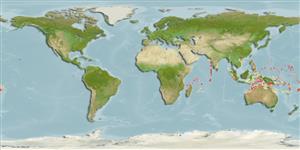>
Anguilliformes (Eels and morays) >
Muraenidae (Moray eels) > Uropterygiinae
Etymology: Anarchias: Greek, anarchia, -as = without a chief, lack of authority (Ref. 45335).
More on author: Schultz.
Environment: milieu / climate zone / profondeur / distribution range
Écologie
marin récifal. Tropical; 19°N - 21°S (Ref. 85321)
Indo-West Pacific: tropical, from central Indian Ocean in the west to the Phoenix and Line Islands in the east; southernmost records from about 21°S in Tonga, northernmost from about 19°N in the Philippines. Not recorded anywhere west of the Maldives, although it reaches as far as Palmyra I. in the east and does not occur in the Hawaiian Islands nor anywhere in French Polynesia.
Taille / Poids / Âge
Maturité: Lm ? range ? - ? cm
Max length : 21.9 cm TL mâle / non sexé; (Ref. 85321)
This species is distinguished from its congeners except A. exulatus and A. schultzi by the position of the fourth supraorbital pore, anteromedial to the posterior nostril and separated from it by an interval of normal, pigmented skin; fewer vertebrae 98-108 (vs. 110-117 in A. exulatus and 105-113 in A. schultzi); longer snout-anus distance 45.1-50.6% TL (vs. 40.3-45.1% in A. exulatus and 41.5-45.1% in A. schultzi); with discrete, sharply defined pale spots (vs. larger, more diffuse pale areas oriented vertically in A. exulatus and uniform brown of A. schultzi) (Ref. 85321).
Body shape (shape guide): eel-like.
Most specimens were collected in relatively shallow water on coral reefs and rocky areas along the shore and are not recorded deeper than 10 m. Cryptic and rarely, if ever seen except when collected with ichthyocides (Ref. 85321).
Life cycle and mating behavior
Maturité | Reproduction | Frai | Œufs | Fécondité | Larves
Reece, J.S., D.G. Smith and E. Holm, 2010. The moray eels of the Anarchias cantonensis group (Anguilliformes: Muraenidae), with description of two new species. Copeia 2010(3):421-430. (Ref. 85321)
Statut dans la liste rouge de l'IUCN (Ref. 130435: Version 2025-1)
Menace pour l'homme
Harmless
Utilisations par l'homme
Pêcheries: sans intérêt
Outils
Articles particuliers
Télécharger en XML
Sources Internet
Estimates based on models
Preferred temperature (Réf.
123201): 26.8 - 29.3, mean 28.5 °C (based on 1746 cells).
Phylogenetic diversity index (Réf.
82804): PD
50 = 0.5005 [Uniqueness, from 0.5 = low to 2.0 = high].
Bayesian length-weight: a=0.00069 (0.00033 - 0.00146), b=3.12 (2.93 - 3.31), in cm total length, based on LWR estimates for this (Sub)family-body shape (Ref.
93245).
Niveau trophique (Réf.
69278): 3.4 ±0.5 se; based on size and trophs of closest relatives
Résilience (Réf.
120179): Haut, temps minimum de doublement de population inférieur à 15 mois (Preliminary K or Fecundity.).
Fishing Vulnerability (Ref.
59153): Low vulnerability (12 of 100).
🛈
